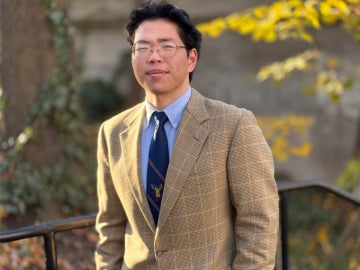Exploring Interstellar Waves
October 12, 2020
Yvonne Gay

Jakob Faber ’21.
Photo credit: Anokha Venugopal
Jakob Faber ’21 spent the month of August exploring ways to broaden the scope of branched flow with the goal of introducing work that has been done in radio astronomy and radio geophysics into the field.
Branched flow is a behavior of waves that have been observed on the widest range of physical scales imaginable, from radio waves shooting across the Milky Way down to tiny wiggling electrons, explains Faber. “When the medium is disordered in such a way that it contains random, smooth variations, like a landscape of mountains and valleys, the wave will begin to divide into multiple, focused beams that resemble the branches of a tree.”
According to Faber, a thorough understanding of the behavior of branched flow can help researchers to answer questions about both the medium through which the waves are passing and the source of the waves, potentially allowing them to predict—or if the system is small enough—control the paths these branches take. The ultimate goal would be for branched flow to fundamentally tie together systems found in every corner of the natural world.
“Branched flow as a field is still very young,” admits Faber. “One of the most pressing questions today is: Does branching also appear in the propagation of light, specifically radio waves, emitted by astrophysical sources? If so, this would greatly benefit our understanding of interstellar space and bring a new lens to the field of radio astronomy.”
During the past three years, Faber has worked with Professor of Physics Dan Stinebring to understand how radio waves behave as they travel through interstellar space. The pair used large radio telescopes to observe pulsars, seen as highly energetic pulses of radio waves in the sky. By observing pulsars, Faber and Stinebring could ask: Is the medium between Earth and the pulsar the special type of randomly smooth medium needed for branched flow to occur?
“The answer, for now, is probably, but of course that’s a terribly unsatisfying thing to hear,” says Faber, a physics major with concentrations in astrophysics and philosophy. “That is why I’ve decided to pursue this question as my honors project.
’’If the answer turns out to be yes, then we will have a new toolkit for modeling radio wave propagation in the interstellar medium. And that will be crucial to identifying and correcting for its influence on pulsar signals, thereby bringing us a galactic distance closer to the astrophysical objects we observe every day.”
Although Faber’s project did not yield conclusive results, time spent discussing possible ways to go about simulating branched flow in the interstellar medium with a professor at Harvard University and Stinebring was productive. Faber was also able to identify a host of branched-flow-related systems and crossovers from quantum mechanics to acoustic oceanography, geophysics, and radio astronomy.
“A consequence of this culture, not unlike branched flow, is the divergence of research fields that are effectively trying to understand the same concepts,” says Faber. “I came to realize early on in the summer that, unbeknownst to most researchers in radio astronomy, the problem of simulating radio wave propagation in the interstellar medium is entirely analogous to some wave-propagation problems on Earth, such as the propagation of microwaves in the atmosphere or even sound waves in the ocean.”
While working on the branched flow project, Faber completed an internship at the University of California, Berkeley. This semester Faber is at Oberlin College.
You may also like…
Nuiko Wadden ’02 Joins Oberlin Conservatory Faculty as Assistant Professor of Harp
The versatile musician brings extensive opera, orchestral, and contemporary music experience to her role
Leo Hidy ’23 Earns 2026 Marshall Scholarship
Leo Hidy ’23, a comparative American studies major who also studied business and economics while at Oberlin, has received a 2026 Marshall Scholarship that will fund two years of graduate study in the UK.
Amy Lee Joins Oberlin Conservatory Faculty as Associate Professor of Violin
The renowned violinist and associate concertmaster of the Cleveland Orchestra brings extensive teaching and performing experience to Oberlin

